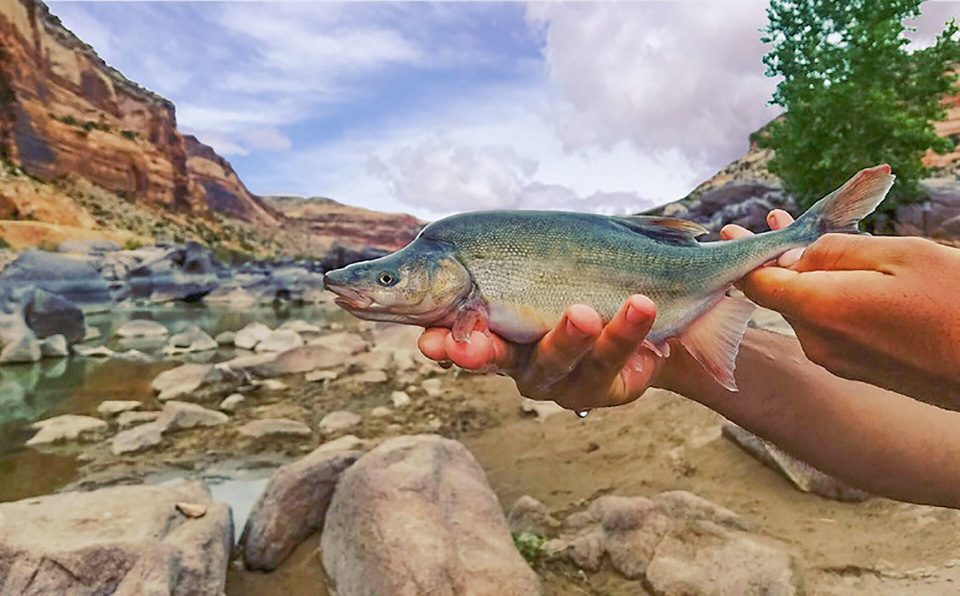DENVER – One of the Colorado River’s native fishes is one-step closer to recovery thanks to the collaborative conservation work of the U.S. Fish and Wildlife Service and numerous state, federal, tribal and private partners.
After a thorough review using the best available science, the Service today proposes to reclassify the humpback chub from endangered to threatened under the Endangered Species Act (ESA). This decision is based on a recent assessment that concluded the humpback chub is no longer in danger of immediate extinction because of ongoing recovery efforts. The proposed rule to reclassify this unique native fish will publish in the Federal Register on January 22, 2020 opening a 60-day public comment period.
Recovery efforts for the humpback chub are a result of a strong collaboration between the Upper Colorado River Endangered Fish Recovery Program and the Glen Canyon Dam Adaptive Management Program. Partners in these two programs have improved conditions by enacting conservation measures, such as restoring river flows through water release from reservoirs, removing non-native predators and introducing humpback chub to new locations across its native range.
“The improved status of the humpback chub would not have been possible without the shared commitment to conservation from all of our partners along this important and vital river,” said U.S. Fish and Wildlife Service Regional Director Noreen Walsh. “Our best chance for continued success rests in the power of these long-term, collaborative partnerships.”
The Colorado River is known for its scenic beauty as it flows over 1,400 miles from the Rocky Mountains to the Gulf of California. The river’s beauty is not just above the surface – it is also found below, with many unique native fish species, including the humpback chub. This member of the minnow family was first documented in the Lower Colorado River Basin in the Grand Canyon in the 1940s and in the upper Colorado River Basin in the 1970s. It was placed on the United States’ original list of endangered species in 1967. This fish is uniquely adapted to live in the swift and turbulent whitewaters found in the canyon-bound areas of the river. The fleshy hump behind its head, which gives the fish its name, and its large, curved fins allow the humpback chub to maintain its position in the swiftly moving current.
The largest population of humpback chub, which is found in the Colorado and Little Colorado rivers in the Grand Canyon of Arizona, has reached a stable population of about 12,000 adults. Surveys also recently identified fish living in smaller tributaries in the Grand Canyon, further supporting the species’ viability in the wild. Four smaller populations in the Green and Colorado rivers of the Upper Colorado River Basin have also remained stable over the last 10-15 years. One of the factors that led to the decision to downlist the species is that all five populations have naturally remained stable without the need for stocking with hatchery-raised fish. These population gains, when coupled with ongoing flow management and non-native predatory fish control, led the Service to conclude that the humpback chub is no longer in danger of immediate extinction.
Despite these recent conservation gains, there are still threats to the humpback chub. Habitat alterations from changes in river flows and persistent drought, as well as competition and predation from invasive species, still pose a risk to the fish. The Service will continue working with our partners to mitigate these threats and monitor the population throughout its range.
In conjunction with this proposed change in status, the Service is proposing to utilize provisions under section 4(d) of the ESA. Under the proposed rule, the Service will no longer regulate “take” (harm or mortality) of humpback chub associated with certain conservation actions that benefit the fish. The 4(d) rule will also reduce the regulatory requirements for state fish and wildlife agencies, and other non-federal stakeholders to create refuge populations, expand the range of the species, remove non-native fishes and create catch-and-release fishing opportunities.
A 4(d) rule is one of many tools within the ESA. It allows the Service to tailor protections for threatened species to those that are most needed for the conservation of the species, while eliminating the regulatory burden of restrictions that serve no additional conservation benefit.
The Service will accept comments on the proposed rule and any new information on the species, threats to its viability and actions that may impact the species, for 60 days from January 22 until March 23, 2020. To review and learn more about the species status assessment, proposed rule and how to submit comments, please visit: https://coloradoriverrecovery.org/events-news/updates-documents.html.
For additional information about humpback chub conservation, visit: https://ecos.fws.gov/ecp0/profile/speciesProfile?sId=3930.
